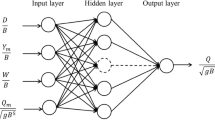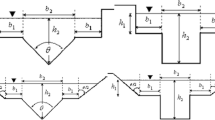Abstract
A side orifice created in the side of a channel is a structure for diverting some of the flow from the main channel for different purposes. The prediction of the discharge through this side structure is very important in hydraulic and irrigation engineering. In the present study, three artificial neural network models including feed forward back propagation, radial basis function, and Generalized Regression neural networks as well as a multiple non-linear regression method were used to predict the discharge coefficient for flow through both square and circular shapes of sharp-crested side orifices. The discharge coefficient was modeled as a function of five input non-dimensional variables resulted from five dimensional variables, which were the type of orifice shape, the diameter or width of the orifice, crest height, depth and velocity of approach flow. The results obtained in this study indicated that all of the neural network models could successfully predict the discharge coefficient with adequate accuracy. However, according to different performance measures, the accuracy of radial basis function approach was a bit better than two other neural network models. The neural network models predicted the discharge coefficient more accurately than the non-linear regression relation.
Similar content being viewed by others
References
Aghayari, F., Honar, T., and Keshavarzi, A. (2009). “A study of spatial variation of discharge coefficient in broad-crested inclined side weirs.” Journal of Irrigation Drainage Engineering, Vol. 58, No. 2, pp. 246–54, DOI: 10.1002/ird.416.
Benning, R. M., Becker, T. M., and Delgado, A. (2001). “Initial studies of predicting flow fields with an ANN hybrid.” Advances in Engineering Software, Vol. 32, No. 12, pp. 895–901, DOI: 10.1016/S0965-9978(01)00043-6.
Bilhan, O., Emiroglu, M. E., and Kisi, Ö. (2010). “Application of two different neural network techniques to lateral outflow over rectangular side weirs located on a straight channel.” Advances in Engineering Software, Vol. 41, No. 6, pp. 831–837, DOI: 10.1016/j.advengsoft.2010.03.001.
Bilhan, O., Emiroglu, M. E., and Kisi, Ö. (2011). “Use of artificial neural networks for prediction of discharge coefficient of triangular labyrinth side weir in curved channels.” Advances in Engineering Software, Vol. 42, No. 4, pp. 208–214, DOI: 10.1016/j.advengsoft.2011.02.006.
Borghei, M., Jalili, M. R., and Ghodsian, M. (1999). “Discharge coefficient for sharp crested side weir in subcritical flow.” Journal of Hydraulic Engineering, Vol. 125, No. 10, pp. 1051–1056, DOI: 10.1061/(ASCE)0733-9429(1999)125:10(1051).
Bryant, D. B., Khan, A. A., and Aziz, N. M. (2008). “Investigation of flow upstream of orifices.” Journal of Hydraulic Engineering, Vol. 134, No. 1, pp. 98–104, DOI: 10.1061/(ASCE)0733-9429(2009)135:2(158).
Cosar, A. and Agaccioglu, H. (2004). “Discharge coefficient of a triangular side weir located on a curved channel.” Journal of Irrigation Drainage Engineering, Vol. 130, No. 5, pp. 321–33, DOI: 10.1061/(ASCE)0733-9437(2004)130:5(410).
Doszkocs, T. E., Reggia, J., and Lin, X. (1990). “Connectionist models and information retrieval.” Annual Review of Information Science and Technology, Vol. 25, pp. 209–260.
Emiroglu, M., Kaya, N., and Agaccioglu, H. (2010). “Discharge capacity of labyrinth side weir located on a straight channel.” Journal of Irrigation Drainage Engineering, Vol. 136, No. 1, pp. 37–46. DOI: 10.1061/(ASCE)IR.1943-4774.0000112.
Emiroglu, M. E., Bilhan, O., and Kisi, Ö. (2011). “Neural networks for estimation of discharge capacity of triangular labyrinth side-weir located on a straight channel.” Expert Systems with Applications, Vol. 38, No. 1, pp. 867–874, DOI: 10.1016/j.eswa.2010.07.058.
Gill, M. A. (1987). “Flow through side slots.” Journal of Environmental Engineering, Vol. 113, No. 5, pp. 1047–1057, DOI: 10.1061/(ASCE)0733-9372(1987)113:5(1047).
Haykin, S. (1999). Neural networks: A comprehensive foundation (2nd ed.) Upper Saddle Rever, New Jersey: Prentice Hall.
Hussain, A., Ahmad, Z., and Asawa, G. L. (2010). “Discharge characteristics of sharp-crested circular side orifices in open channels.” Journal of Flow Measurement and Instrumentation, Vol. 21, No. 3, pp. 418–424, DOI: 10.1016/j.flowmeasinst.2010.06.005.
Hussain, A., Ahmad, Z., and Asawa, G. L. (2011). “Flow through sharpcrested rectangular side orifices under free flow condition in open channels.” Agricultural Water Management, Vol. 98, No. 10, pp. 1536–1544, DOI: 10.1016/j.agwat.2011.05.004.
Karami, H., Ardeshir, A., Saneie, M., and Salamatian, S. A. (2012). “Prediction of time variation of scour depth around spur dikes using neural networks.” Journal of Hydroinformatics, Vol. 14, No. 1, pp. 180–191, DOI: 10.2166/hydro.2011.106.
Keshavarzi, A., Gazni, R., and Homayoon, S. R. (2012). “Prediction of scouring around an arch-shaped bed sill using Neuro-Fuzzy model.” Applied Soft Computing, Vol. 12, No. 1, pp. 486–493, DOI: 10.1016/j.asoc.2011.08.019.
Kisi, Ö. E., miroglu, M. E., Bilhan, O., and Güven, A. (2012). “Prediction of lateral outflow over triangular labyrinth side weirs under subcritical conditions using soft computing approaches.” Expert Systems with Applications, Vol. 39, No. 3, pp. 3454–3460, DOI: 10.1016/j.eswa.2011.09.035.
Kocabas, F., Ünal, S., and Ünal, B. (2008). “A neural network approach for prediction of critical submergence of an intake in still water and open channel flow for permeable and impermeable bottom.” Computers & Fluids, Vol. 37, No. 8, pp. 1040–1046, DOI: 10.1016/j.compfluid.2007.11.002.
Naseri, M. and Othman, F. (2012). “Determination of the length of hydraulic jumps using artificial neural networks.” Advances in Engineering Software, Vol. 48, pp. 27–31, DOI: 10.1016/j.advengsoft.2012.01.003.
Ojha, C. S. P. and Subbaiah, D. (1997). “Analysis of flow through lateral slot.” Journal of Irrigation Drainage Engineering, Vol. 123, No. 5, pp. 402–405, DOI: 10.1061/(ASCE)0733-9437(1997)123:5(402).
Pinar, E., Paydas, K., Seckin, G., Akilli, H., Sahin, B., Cobaner, M., Kocaman, S., and Akar, A. (2010). “Artificial neural network approaches for prediction of backwater through arched bridge constrictions.” Advances in Engineering Software, Vol. 41, No. 4, pp. 627–635. DOI: 10.1016/j.advengsoft.2009.12.003.
Ramamurthy, A. S., Udoyara, S. T., and Serraf, S. (1986). “Rectangular lateral orifices in open channel.” Journal of Environmental Engineering, Vol. 112, No. 2, pp. 292–300, DOI: 10.1061/(ASCE)0733-9372(1986)112:2(292).
Ramamurthy, A. S., Udoyara, S. T., and Rao, M. V. J. (1987). “Weir orifice units for uniform flow distribution.” Journal of Environmental Engineering, Vol. 113, No. 1, pp. 155–166, DOI: 10.1061/(ASCE)0733-9372(1987)113:1(155).
Riahi-Madvar, H., Ayyoubzadeh, S. A., and Gholizadeh Atani, M. (2011). “Developing an expert system for predicting alluvial channel geometry using ANN.” Expert Systems with Applications, Vol. 38, No. 1, pp. 215–222, DOI: 10.1016/j.eswa.2010.06.047.
Seckin, G., Akoz, M. S., Cobaner, M., and Haktanir, T. (2009). “Application of ANN techniques for estimating backwater through bridge constrictions in Mississippi River basin.” Advances in EngineeringSoftware, Vol. 40, No. 10, pp. 1039–1046, DOI: 10.1016/j.advengsoft.2009.03.002.
Specht, D. F. (1991). “A general regression neural network.” IEEE Transactions on Neural Networks, Vol. 2, No. 6, pp. 568–576, DOI: 10.1109/72.97934.
Swamee, P. K., Santosh, K. P., and Masoud, S. A. (1994). “Side weir analysis using elementary discharge coefficient.” Journal of Irrigation Drainage Engineering, Vol. 120, No. 4, pp. 742–55, 10.1061/ (ASCE)0733-9437(1994)120:4(742).
Ünal, B., Mamak, M., Seckin, G., and Cobaner, M. (2010). “Comparison of an ANN approach with 1-D and 2-D methods for estimating discharge capacity of straight compound channels.” Advances in Engineering Software, Vol. 41, No. 2, pp. 120–129, DOI: 10.1016/j.advengsoft.2009.10.002.
Yu, H., Xie, T., Paszezynski, S., and Wilamowski, B. M. (2011). “Advantages of radial basis function networks for dynamics system design.” IEEE Transactions on Industrial Electronics, Vol. 58, No. 12, pp. 5438–5450, DOI: 10.1109/TIE.2011.2164773.
Yuhong, Z. and Wenxin, H. (2009). “Application of artificial neural network to predict the friction factor of open channel flow.” Communications in Nonlinear Science and Numerical Simulation, Vol. 14, No. 5, pp. 2373–2378, DOI: 10.1016/j.cnsns.2008.06.020.
Author information
Authors and Affiliations
Corresponding author
Rights and permissions
About this article
Cite this article
Eghbalzadeh, A., Javan, M., Hayati, M. et al. Discharge prediction of circular and rectangular side orifices using artificial neural networks. KSCE J Civ Eng 20, 990–996 (2016). https://doi.org/10.1007/s12205-015-0440-y
Received:
Accepted:
Published:
Issue Date:
DOI: https://doi.org/10.1007/s12205-015-0440-y




